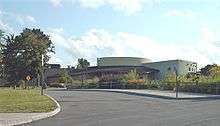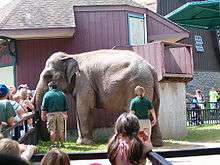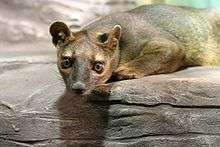Rosamond Gifford Zoo
|
Rosamond Gifford Zoo logo | |
 Main building and entrance to the zoo | |
| Date opened | 1914; 1986 |
|---|---|
| Location | Syracuse, New York, United States |
| Coordinates | 43°02′32″N 76°10′52″W / 43.04222°N 76.18111°WCoordinates: 43°02′32″N 76°10′52″W / 43.04222°N 76.18111°W |
| Land area | 43 acres (17 ha)[1] |
| No. of animals | 900+[2] |
| Memberships | AZA[3] |
| Website |
www |
The Rosamond Gifford Zoo at Burnet Park is a zoo in Syracuse, New York. It is owned and operated by Onondaga County Parks with support from Friends of the Zoo. The zoo is home to more than 700 animals on 43 acres (17 ha). Some of the more popular animals include Asian elephants, Humboldt penguins, Amur tigers, and African lions. The zoo also houses a conservation education center, banquet/meeting space, Jungle Cafe, and gift shop.
The Rosamond Gifford Zoo has been an accredited member of the Association of Zoos and Aquariums (AZA) since 1987.
History
- Origins
The first incarnation of the zoo was a small, four acre facility in Burnet Park owned and operated by the Syracuse Department of Parks and Recreation. After opening in 1914, the zoo's first expansion began in 1916 with the construction of stone exhibits for bears and a waterfowl pond. By 1933, the zoo had doubled in size, and by in 1955 a children's zoo and monkey exhibit had been built.[1]
- Decline
The zoo's decline began in the early 1960s as Syracuse's tax base started to shrink and financial support for the zoo began to erode. In 1974, two teens broke into the zoo and managed to kill and injure about forty animals. The city's financial position and the break-in fueled public debate over the future of the zoo.[1]
Despite the creation of the Friends of the Burnet Park Zoo in 1970 and a grant received by the city to enlarge the zoo to 18 acres (7.3 ha), add a boardwalk, a western plains habitat, and construct a new perimeter fence, the city of Syracuse transferred control of the zoo to Onondaga County Parks in 1979.[1]
- Renewal
A study by County Parks staff produced a forty-page renovation plan for the zoo which involved shutting down the old zoo and constructing another. The plan was approved by the Onondaga County legislature in 1981. The old zoo was closed in 1982 and the thirteen million dollar project (ten million of which was provided by the county and the rest by the Friends of the Burnet Park Zoo) began in 1983.
The zoo reopened in 1986 and received its accreditation from the Association of Zoos and Aquariums the following year; it was re-accredited a decade later. The zoo initiated a capital campaign in 1998 to fund a new conservation and education center and tiger and rainforest exhibits. Following a two million dollar endowment by the Rosamond Gifford Charitable Corporation in 1999, the zoo was renamed the Rosamond Gifford Zoo at Burnet Park.
The next several years saw the introduction of the zoo's first lion cubs in over a decade, as well as the creation of a tiger trail featuring a family of Amur tigers, a social animal exhibit, and a penguin exhibit, which was completed in 2005 and featured eighteen Humboldt penguins. Since then the zoo has successfully raised numerous penguin chicks. During this period the zoo became the second in the United States to successfully raise red panda triplets. Asian elephants, Amur tigers, Humboldt penguins, snow leopards, golden lion tamarins, markhor goats and red pandas, all threatened species in the wild, are among those that have been bred successfully at Rosamond Gifford Zoo at Burnet Park.
Exhibits
- U.S.S. Antiquities Aquarium
The U.S.S. Antiquities Aquarium is an exhibit that simulates a submarine voyage through time from life's earliest days in the ocean to living on land. Exhibits range in size and include insects, aquatic life, reptiles and amphibians. Fish species include clownfish, cow fish, archerfish and bass. Amphibians species include poison dart frogs and hellbenders. Reptiles species include dwarf caimans, reticulated python, yellow-spotted Amazon River turtles, and collared lizards.
- Adaptations
The Adaptations exhibit features animals that have in some way adapted to their surroundings in nature with a main focus on nocturnal adaptions. Animals include North American river otters, ocelots, Egyptian fruit bats, fennec foxes, naked mole rats, prehensile-tailed skinks, seahorses, and Hoffmann's two-toed sloths.
- Diversity of Birds Aviary
The aviary is a large, one-room free flight exhibit that primarily features warm weather birds such as the scarlet ibis, roseate spoonbill, and Nicobar pigeon.
- Social Animals and Rainforest
This exhibit is home to animals that live together in groups and includes African lions, squirrel monkeys, golden lion tamarins, patas monkeys, lemurs, siamangs, meerkats, and fossa.[2] The zoo has had recent success with breeding patas monkeys and currently has the nation's second largest troop.
- Outdoor Birds
This exhibit showcases aquatic birds including the Chilean flamingo, the North American wood duck, and the American common goldeneye. Other smaller exhibits feature laughing kookaburras, turkey vultures, peregrine falcons, barn owls, and Temenicks tragopans.
- Wildlife Trails
Wildlife Trails is a 0.5-mile (0.8 km) trail that takes visitors past animals such as caribou, blue cranes, markhor goats, Amur tigers, owls, bald eagles, red wolf, Thorold's deer, elephants, red pandas, Humboldt penguins, spectacled bears, Andean condors, Reeve's muntjacs, Asian elephants, Siberian lynx, fishers, grey wolves, and snow leopards.[2][4]
- Asian Elephant Preserve

In December 2007, the Onondaga County Legislature approved a six million dollar expansion of the elephant exhibit with the expectation that the expansion will allow the elephant breeding program to grow in the future. In August 2011, it was completed and dubbed as the Asian Elephant Preserve. The exhibit is home to the zoo's famous Asian elephant herd. The new exhibit features a spacious yard and a new holding facility with room for up to 12 elephants.
The zoo breeds and houses Asian elephants and is regarded by some as one of the greatest breeding programs of its kind.[5]
In a recent Harris Interactive Poll, 95 percent of respondents agreed that seeing elephants in zoos helps people appreciate them more. That same poll found that 86 percent of respondents believe that visiting zoos and aquariums encourages people to donate time and/or money to conservation. While television, books, movies and videos can provide factual information, they cannot match the emotional impact of seeing live animals.
As part of its elephant program, zoo staff regularly brings the elephants to the fence line to meet the public. Children love having the opportunity to connect with an elephant. The zoo wants its visitors to develop a connection so that they will care enough to get involved in protecting our planet.
As an educator who managed and conducted the Zoo’s outreach program (Zoo to You) for two years, I was moved whenever someone would approach me with a smile about our elephants. Probably the encounter that I remember the most is when I was conducting a program and I addressed a question asked about our elephants. After the program had ended and I was preparing to leave, a girl of about 7 years old approached me and said ‘Do you know Siri?’ I responded that yes, I did. She then said, ‘I do, too. I know Siri. I had my birthday party there, and I touched her. I know her.’ It’s moments like that when I realize how important it is for the Zoo’s elephants to be touchable. Truly, it is our job to get them close enough to care.
–Nathan Keefe, Director of Education at the Rosamond Gifford Zoo at Burnet Park
- Domestic Animal Barn
The Domestic Animal Barn exhibit features Guinea hogs, miniature donkey, alpacas, sheep, and goats.
- Primate Park
Primate Park, which opened in 2010, is an outdoor exhibit with mesh walls, swinging vines, large rocks, and a waterfall which exhibits siamangs and patas monkeys on a rotating basis.[6] This new exhibit replaces the old "Monkey Island" in the same location that featured a small climbing structure surrounded by a small moat which was used to exhibit white-handed gibbons.
Outreach
Outreach animals are used for educational outreach programs and include creatures such as emperor scorpions, the Honduran milk snake, and various parrots and birds of prey.
New exhibits
The zoo has been updating and renovating old exhibits and building new ones. In 2013, the zoo opened a new giant Pacific octopus exhibit outside of the U.S.S. Antiquities area, a first for the zoo.
References
- 1 2 3 4 "Rosamond Gifford Zoo at Burnett Park". rosamondgiffordzoo.org. Rosamond Gifford Zoo. Retrieved 15 September 2010.
- 1 2 3 "Animals Overview". rosamondgiffordzoo.org. Rosamond Gifford Zoo. Retrieved 15 September 2010.
- ↑ "List of Accredited Zoos and Aquariums". aza.org. Association of Zoos and Aquariums. Retrieved 5 September 2010.
- ↑ "Zoo Map". rosamondgiffordzoo.org. Rosamond Gifford Zoo. Retrieved 15 September 2010.
- ↑ Weiner, Mark (14 August 2005). "USDA to Investigate Baby Elephant's Death in Syracuse". elephants.com. The Elephant Sanctuary. Retrieved 15 September 2010.
- ↑ ""Primate Park" opens at Rosamond Gifford Zoo". 9wsyr.com. Newport Television LLC. 15 July 2010. Retrieved 15 September 2010.
External links
 Media related to Rosamond Gifford Zoo at Wikimedia Commons
Media related to Rosamond Gifford Zoo at Wikimedia Commons- Official website

